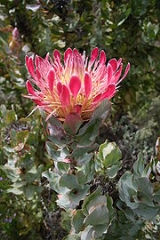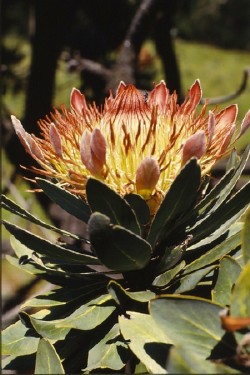
Protea eximia
Encyclopedia
Protea eximia, the broad-leaved sugarbush is a shrub that may become a small tree, which occurs in mountain fynbos
on mainly acidic sandy soils; the species was very well known under its old name of Protea latifolia. The flowers have awns that are covered in purple-black velvety hairs, and are contained within a series of rings of involucral bracts
that have the appearance of petals. The fruit is a densely hairy nut
, many of which are inserted on a woody base. The flowers are borne terminally on long shoots, and have a tendency to become very untidy as they age.
at the base, tips acute; leathery, nude, glaucous. Flowers inverted cones, 100 - 140mm in length, 80 -120mm in diameter when fully open, base shallow cone, pointed, 25 - 30mm wide, 15 - 20mm high. Involucral bracts in 5 - 6 series, clearly differentiated into an outer- and inner-series, outer surface silky; outer-series oval to broad elongated oval, 10 - 15mm wide, 10 - 25mm long, tips rounded to acute, margins ciliate, greenish yellow to yellowish orange with wide blackish margins; inner-series acuminate
to spatulate
, 8 - 15mm wide and 40 - 100mm in length, yellowish near the base to pale crimson
at the tips.
species
was discovered by James Niven ca. 1805 while on a journey of discovery in the Swartberg, Cape Province
, South Africa
(Black Mountains). Within 5 years the species was under cultivation in the Cape, and was later exported for cultivation in Europe. Protea eximia is widely distributed in the far south of Africa along the coastal mountains, from Worcester in the West to Port Elizabeth in the east. The species is encountered in a wide variety of habitats, altitudes, and temperature regimes. This versatility has resulted in it being brought into bloom outside as far north as the coast of Cornwall
in the United Kingdom
.
Dense communities of these plants occur in the wild, to the extent that their density can make them virtually impenetrable. Such communities can be very large, and may stretch across several kilometres in their natural habitat. A natural thinning of these stands occurs over time, leaving fewer and larger specimens. They flower mainly in the months of August, September and October, but may begin as early as July and last until December. The large colourful inflorescence
s are a magnificent sight when the stands are large and dense.
Fynbos
Fynbos is the natural shrubland or heathland vegetation occurring in a small belt of the Western Cape of South Africa, mainly in winter rainfall coastal and mountainous areas with a Mediterranean climate...
on mainly acidic sandy soils; the species was very well known under its old name of Protea latifolia. The flowers have awns that are covered in purple-black velvety hairs, and are contained within a series of rings of involucral bracts
Bract
In botany, a bract is a modified or specialized leaf, especially one associated with a reproductive structure such as a flower, inflorescence axis, or cone scale. Bracts are often different from foliage leaves. They may be smaller, larger, or of a different color, shape, or texture...
that have the appearance of petals. The fruit is a densely hairy nut
Nut (fruit)
A nut is a hard-shelled fruit of some plants having an indehiscent seed. While a wide variety of dried seeds and fruits are called nuts in English, only a certain number of them are considered by biologists to be true nuts...
, many of which are inserted on a woody base. The flowers are borne terminally on long shoots, and have a tendency to become very untidy as they age.
Description
An upright, somewhat sparsely branched shrub to small tree from 2 - 5m in height and up to 300mm in diameter. The flowering stems are 7 - 10mm in diameter, initially hairy becoming nude. Leaves are semi-flattened to flattened, 60 - 100mm in length, 30 - 65mm broad, oval to elongated oval, strongly chordateLeaf shape
In botany, leaf shape is characterised with the following terms :* Acicular : Slender and pointed, needle-like* Acuminate : Tapering to a long point...
at the base, tips acute; leathery, nude, glaucous. Flowers inverted cones, 100 - 140mm in length, 80 -120mm in diameter when fully open, base shallow cone, pointed, 25 - 30mm wide, 15 - 20mm high. Involucral bracts in 5 - 6 series, clearly differentiated into an outer- and inner-series, outer surface silky; outer-series oval to broad elongated oval, 10 - 15mm wide, 10 - 25mm long, tips rounded to acute, margins ciliate, greenish yellow to yellowish orange with wide blackish margins; inner-series acuminate
Leaf shape
In botany, leaf shape is characterised with the following terms :* Acicular : Slender and pointed, needle-like* Acuminate : Tapering to a long point...
to spatulate
Leaf shape
In botany, leaf shape is characterised with the following terms :* Acicular : Slender and pointed, needle-like* Acuminate : Tapering to a long point...
, 8 - 15mm wide and 40 - 100mm in length, yellowish near the base to pale crimson
Crimson
Crimson is a strong, bright, deep red color. It is originally the color of the dye produced from a scale insect, Kermes vermilio, but the name is now also used as a generic term for those slightly bluish-red colors that are between red and rose; besides crimson itself, these colors include...
at the tips.

Habitat
This proteaProtea
Protea is both the botanical name and the English common name of a genus of flowering plants, sometimes also called sugarbushes.-Etymology:...
species
Species
In biology, a species is one of the basic units of biological classification and a taxonomic rank. A species is often defined as a group of organisms capable of interbreeding and producing fertile offspring. While in many cases this definition is adequate, more precise or differing measures are...
was discovered by James Niven ca. 1805 while on a journey of discovery in the Swartberg, Cape Province
Cape Province
The Province of the Cape of Good Hope was a province in the Union of South Africa and subsequently the Republic of South Africa...
, South Africa
South Africa
The Republic of South Africa is a country in southern Africa. Located at the southern tip of Africa, it is divided into nine provinces, with of coastline on the Atlantic and Indian oceans...
(Black Mountains). Within 5 years the species was under cultivation in the Cape, and was later exported for cultivation in Europe. Protea eximia is widely distributed in the far south of Africa along the coastal mountains, from Worcester in the West to Port Elizabeth in the east. The species is encountered in a wide variety of habitats, altitudes, and temperature regimes. This versatility has resulted in it being brought into bloom outside as far north as the coast of Cornwall
Cornwall
Cornwall is a unitary authority and ceremonial county of England, within the United Kingdom. It is bordered to the north and west by the Celtic Sea, to the south by the English Channel, and to the east by the county of Devon, over the River Tamar. Cornwall has a population of , and covers an area of...
in the United Kingdom
United Kingdom
The United Kingdom of Great Britain and Northern IrelandIn the United Kingdom and Dependencies, other languages have been officially recognised as legitimate autochthonous languages under the European Charter for Regional or Minority Languages...
.
Dense communities of these plants occur in the wild, to the extent that their density can make them virtually impenetrable. Such communities can be very large, and may stretch across several kilometres in their natural habitat. A natural thinning of these stands occurs over time, leaving fewer and larger specimens. They flower mainly in the months of August, September and October, but may begin as early as July and last until December. The large colourful inflorescence
Inflorescence
An inflorescence is a group or cluster of flowers arranged on a stem that is composed of a main branch or a complicated arrangement of branches. Strictly, it is the part of the shoot of seed plants where flowers are formed and which is accordingly modified...
s are a magnificent sight when the stands are large and dense.

